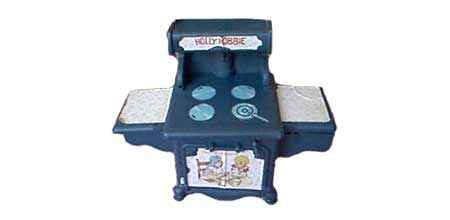Holly Hobbie Oven

Synopsis of Toy
If your best friend challenged you to a bake-off war in the 1970’s and it was weapon-choosing time, popular options were the Easy-Bake Oven or the Holly Hobbie Oven. The former was made with plastics and decorated in a pastel palette and connoted a feeling of swanky suburbia. The Holly Hobbie Oven was faux blue caste iron—it exuded sturdiness and old-fashioned values, and well, it was a lot heavier than the Easy-Bake (and there’s a tacit domestic belief that the clunkier the appliance, the better it works). The Holly Hobbie also came with a wider array of homey kitchen accessories: a cake pan, a pie pan, cookie cutters (shaped like our favorite bonneted lovely), a bowl for stirring, a wooden spoon, and a wooden rolling pin. The Easy-Bake won in kitsch value, but surely the Holly Hobbie prevailed in practicality.
After the war and race riots and cultural upheaval of the 1960’s, plenty of Americans turned away from things modern in favor of the more peaceful, predictable past. Increasingly popular Americana and comfy folk style helped make Holly Hobbie a big star in the toy world. She was introduced via greeting cards in 1967, and ten years later, she was the most sought after female licensed character in the world. There were products galore—dolls and clothes and bed sheets and wallpaper and toys. Holly Hobbie licensers encouraged little girls to partake in domestic activities like baking and sewing—activities that Holly Hobbie herself would surely smile upon, especially if you the baker or sewer was using Holly Hobbie product to create their homey magic with.
Collectors and nostalgia buffs still debate the virtues of teh dueling 70's ovens, and each has its coterie of fans—but let’s face it, the eatin's were adorable and delicious from both.
Release History of Toy
1967 - Holly Hobbie appears in greeting cards1975 - Holly Hobbie Oven
Sub Categories of Toys
arts & craftshobbies
